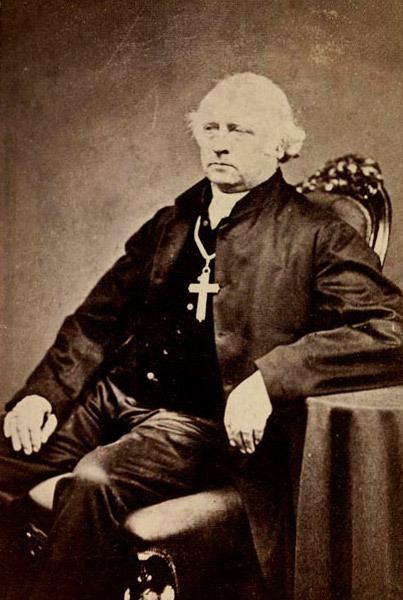Installed 16 September 1866 Term ended March 1, 1872 Ordination 1839 | Consecration August 15, 1866 Name Laurence Sheil | |
 | ||
Successor Archbishop Christopher Reynolds Diocese Roman Catholic Archdiocese of Adelaide | ||
Laurence Bonaventure Sheil OFM (24 December 1815 – 1 March 1872) was an Irish Franciscan friar, who served as the third Roman Catholic Bishop of Adelaide. Born in Ireland, he was educated at St Peter's College, Wexford, and at the Franciscan College of St Isidore, Rome, Sheil was sent to the British Colony of New South Wales in Australia after being ordained a priest. There, he served as an educator and administrator, before poor health saw him move to Ballarat as archdeacon.
Contents
In 1866, Sheil became the third Bishop of Adelaide. His reign was characterised by poor administration, with his extensive absence from the diocese contributing to severe factionalism within the clergy. Sheil's mismanagement culminated in his excommunication of Mary MacKillop, who later became Australia's first saint. He died in March 1872, rescinding his excommunication of MacKillop on his deathbed.
Early life
Sheil was born on 24 December 1815 in Wexford, Ireland. From 1832, he attended the Franciscan College of St Isidore in Rome, where he taught after he was ordained in 1839. After serving as guardian of the convents of St Francis at Cork and Carrickbeg, Sheil travelled to Melbourne, Australia, arriving on 12 February 1853. There, he served as the secretary and manager of the Victorian Catholic education board, and taught at a Melbourne seminary. Sheil's failing health saw him moved to Ballarat in 1859, where he became archdeacon. In 1866 he was chosen to replace Patrick Geoghegan as Bishop of Adelaide.
Episcopacy
After being consecrated on 15 August 1866 by Bishop of Melbourne, James Goold, Sheil was installed as Bishop of Adelaide on 16 September, that year.
The diocese of Australia expanded significantly during Sheil's term as bishop. The number of priests rose from 17 to 30, and a number of new parishes were founded. The founding of the Sisters of St. Joseph in 1866 by Mary Mackillop and Julian Tenison Woods contributed to a large improvement in Catholic education within the diocese. Sheil appointed Woods as the director general of Catholic education in the diocese, and by 1871, there were 71 Catholic schools in the diocese, more than half run by the Josephites.
Although Sheil had been an effective educator in Victoria, his episcopacy was characterised by weak leadership and poor administration. His travels to Europe to recruit priests and attend the First Vatican Council meant that he spent less than two years of his six-year reign in the diocese. In the absence of effective leadership, clergy disunity became rife, with a factional grouping forming around the Franciscan priest Charles Horan. In 1871, when Sheil returned from a visit to Europe, Horan's faction alleged that the Josephites were incompetent and ignorant, petitioning him to take direct control of the order. Sheil, who was increasingly acting under Horan's influence, demoted Tenison Woods from his administrative position within the diocese, disbanded the Josephite novitiate and brought the Sisters of St. Joseph directly under his control. In doing so, he removed Tenison Woods and MacKillop from their positions of influence within the order. MacKillop strongly objected, and in response, Sheil excommunicated her for disobedience. The excommunication prompted further disunity amongst South Australian Catholics, with letters criticising the Bishop in local papers. Prompted by these events, a group of Catholic laymen wrote to Cardinal Alessandro Barnabò, Prefect of the Congregation of the Propagation of the Faith in Rome. The letter was strongly critical of Sheil's excommunication of MacKillop, the management of diocesan finances and impropriety within the clergy.
Throughout early 1872, Sheil's became steadily more ill. On his deathbead in Willunga, he rescinded his excommunication of MacKillop, claiming he had been betrayed by his advisors. He died of a carbuncle on 1 March 1872.
Legacy
After Sheil's death, two reports into his episcopacy and the state of the Diocese of Adelaide were conducted. The first, written by a Jesuit priest in the diocese to his Father-General in Rome, was fiercely critical of Sheil's recruitment of priests from Ireland. Of the 21 priests he had brought to the diocese, the report stated that one had died, one had such poor health as to be useless, five had been dismissed for impropriety, five had insufficient knowledge to be effective as priests and six had become involved in diocesan factionalism. Not only, the report alleged, had only two of the twenty-one recruited priests been useful, but many of them had known deficiencies before Sheil recruited them.
The second report, commissioned by the Congregation of the Propagation of the Faith, was conducted by Bishop of Hobart Daniel Murphy and Bishop of Bathurst Matthew Quinn. Murphy and Quinn travelled around the diocese, inspecting parishes and collecting evidence. Having concluded their investigations, they expelled Charles Horan and other factional leaders from the diocese, and recommended Christopher Reynolds (who had been acting as administrator of the Diocese since Sheil's death) be appointed as the next Bishop of Adelaide.
